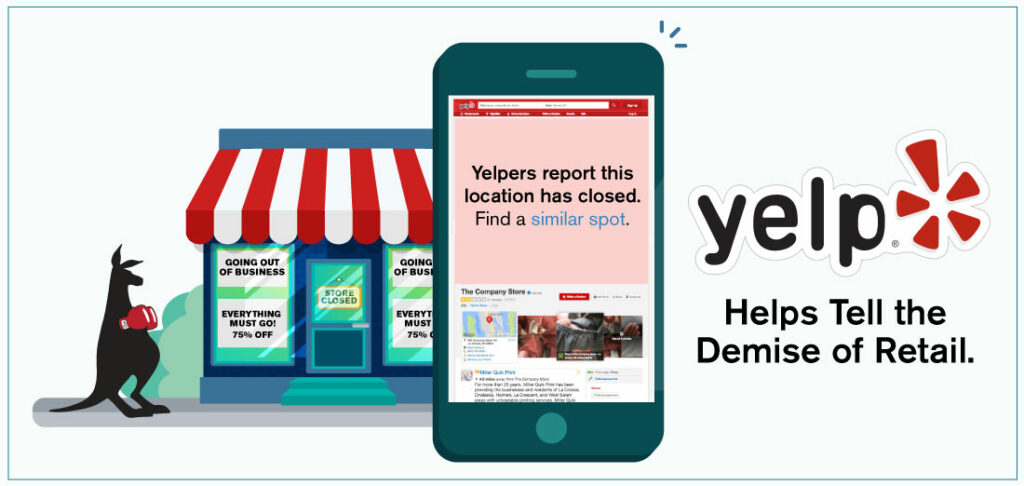Are we in the midst of the beginning of the end for retail?
While we tend not to refer people to Yelp, (since it’s killing the modern day referral), in this case we can look to Yelp for that answer. A Harvard Business School study released February 20th uses Yelp analytics to determine retail and neighborhood demographics.
Brick and mortar stores will most likely, at some level, always be around. A certain group of consumers won’t be able to give up trekking to a showroom to check out the latest luxury vehicle spinning around on its platform or visiting a watch shop to see their shiny, expensive purchase up-close and personal before paying for it. However, recent data suggests that retail may be in its demise, or at the very least on a down swing, and Yelp (I know I know, we aren’t always fans of theirs!) has a major part in telling that story.
To measure neighborhood change and the gentrification in the U.S., two Harvard Business School researchers and one from Harvard University teamed up to look at the topic with a study that, in part, uses Yelp’s analytics to measure real-time economic activity in certain neighborhoods. Traditional information gathering tools like the Census Bureau, which is conducted every 10 years, is usually too slow to provide accurate measurements.
Yelp, on the other hand, has a running database of when businesses open and shutter their doors as well as neighborhood demographics. With the help of Yelp analytics, American Community Survey data, and Google Streetview (to see the changing landscape of neighborhoods) the study, Nowcasting Gentrification: Using Yelp Data to Quantify Neighborhood Change, looked at the changing demographics of neighborhoods and how retail stores affect them.
For example, richer neighborhoods are going to attract more storefronts because they have the income to spend in them, while poorer neighborhoods will have fewer stores. Neighborhoods where people can get their venti, non-fat, decaf, sugar-free vanilla, extra-foamy, doubled-blended, iced frap at a Starbucks that suddenly popped up, or any cafe for that matter, signifies the neighborhood may be changing.
And hooray for reviews, WebPunch’s favorite, because the study also suggests, “The number of reviews of Starbucks increases predictive power, suggesting that gentrifying neighborhoods might also attract more reviewers.”
But what about all the retail stores? In a Bloomberg News article about the Harvard study, Yelp provided them with data showing for the first time since they started collecting data (when the site launched in 2004), that in 2017 the number of store closures was higher than the number of openings.

Also, in just the first quarter of 2017 there were more retail store bankruptcies filed than there were the entire 2016 year, according to Bloomberg News numbers. Yikes!

And of course, Yelp is all very proud of their efforts:
Moreover, Yelp data gives a more nuanced look at how the local economy changes as housing prices rise. Data from online platforms like Yelp can help chart the course of a city’s neighborhoods, and can have implications for consumers as well. It’s helpful for home buyers to know that groceries, cafes, or bars opening in a neighborhood are signals of increases in home prices. If you see a new coffee shop enter a neighborhood, that can be a signal of a warming local housing market.
The study is part of Yelp’s ongoing initiative to help researchers like the Harvard team here use Yelp data for economic analyses. Our parallel internal effort, led by Carl Bialik, Yelp’s data science editor, explores how Yelp data can improve our understanding of the world around us. We hope to surface insights that add value to policymakers, businesses, and consumers.
Why the Change?
It’s easy to point the finger at Amazon.com. Looking at the bigger picture, however, it’s really just online shopping in general, albeit largely spearheaded by Amazon. Long-time storefront retailers are also switching to online shopping in an effort to keep up with competition (again, namely Amazon). Other brands like Nordstrom have found a nice in-between by having a sort of staging store instead of a massive department store where customers can go in and try products on, get fitted, and get a personal customer experience, while still making purchases online.
There are also the slew of companies whose model is all about having customers ship products back and forth before actually purchasing something. Stitch Fix and Zappos are two of many companies that will send a box of clothes or shoes to their customers for them to try on. The customer pays for and keeps what they like and returns what they don’t, and the shipping costs are eaten by the business.
Something else to consider is online reviews. People used to go to a store to make a purchase, possibly going in several times before making a consideration. Now, many consumers rely on online reviews to make informed purchases.
Then there are generational gaps. Millennials and maybe even Gen-Xers, as well as baby boomers gone minimalists are spending their money on experiences instead of things. They may spend more time out to eat, at bars, or doing something instead of buying something. And Millennials may even be making some of their purchase decisions on the never-ending pursuit to find the next best social media post, which won’t be at JCPenny’s. For more, see this insightful story by The Atlantic about why the retail storefront may be on the way out.
Apparently, Yelp is here to help. While it’s not necessarily been our experience, Yelp being so helpful, it sounds like it’s found a niche where it can chip in as marketers, researchers, and demographers look for live data tools about consumers and the spaces they live in. For now, we’ll say, “Not bad, Yelp!”

Matthew Van Deventer is a content creator for WebPunch. As a dealer of words, he dabbles in journalism and loves a good story, whatever the medium. Matthew lives outside of Denver, CO with his wife, daughter, and pup, Chewy.


